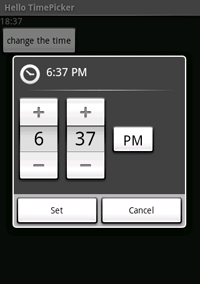To provide a widget for selecting a time, use the TimePicker
widget, which allows the user to select the hour and minute in a familiar interface.
In this tutorial, you'll create a TimePickerDialog, which presents the
time picker in a floating dialog box at the press of a button. When the time is set by
the user, a TextView will update with the new date.
res/layout/main.xml file and insert the following:
<?xml version="1.0" encoding="utf-8"?>
<LinearLayout xmlns:android="http://schemas.android.com/apk/res/android"
android:layout_width="wrap_content"
android:layout_height="wrap_content"
android:orientation="vertical">
<TextView android:id="@+id/timeDisplay"
android:layout_width="wrap_content"
android:layout_height="wrap_content"
android:text=""/>
<Button android:id="@+id/pickTime"
android:layout_width="wrap_content"
android:layout_height="wrap_content"
android:text="Change the time"/>
</LinearLayout>
This is a basic LinearLayout with a TextView
that will display the time and a Button that will open the TimePickerDialog.
HelloTimePicker.java and insert the following class members:
private TextView mTimeDisplay;
private Button mPickTime;
private int mHour;
private int mMinute;
static final int TIME_DIALOG_ID = 0;
This declares variables for the layout elements and time fields.
The TIME_DIALOG_ID is a static integer that uniquely identifies the dialog.
onCreate()
method:
@Override
protected void onCreate(Bundle savedInstanceState) {
super.onCreate(savedInstanceState);
setContentView(R.layout.main);
// capture our View elements
mTimeDisplay = (TextView) findViewById(R.id.timeDisplay);
mPickTime = (Button) findViewById(R.id.pickTime);
// add a click listener to the button
mPickTime.setOnClickListener(new View.OnClickListener() {
public void onClick(View v) {
showDialog(TIME_DIALOG_ID);
}
});
// get the current time
final Calendar c = Calendar.getInstance();
mHour = c.get(Calendar.HOUR_OF_DAY);
mMinute = c.get(Calendar.MINUTE);
// display the current date
updateDisplay();
}
First, the content is set to the main.xml layout and then the TextView and Button are captured with findViewById(int).
Then an View.OnClickListener is created for the Button,
so that when clicked, it will call showDialog(int), passing the unique integer ID for the time picker
dialog. Using showDialog(int) allows the Activity to manage the life-cycle of the dialog and will call the onCreateDialog(int) callback method to request the Dialog
that should be displayed (which you'll define later). After the on-click listener is set, a new
Calendar is created to get the current hour and minute. Finally, the
private updateDisplay() method is called in order to fill the TextView with the current time.
updateDisplay() and pad() methods:
// updates the time we display in the TextView
private void updateDisplay() {
mTimeDisplay.setText(
new StringBuilder()
.append(pad(mHour)).append(":")
.append(pad(mMinute)));
}
private static String pad(int c) {
if (c >= 10)
return String.valueOf(c);
else
return "0" + String.valueOf(c);
}
The updateDisplay() method uses the member fields for the time and inserts them in
the mTimeDisplay TextView. The pad() method returns
the appropriate string representation of the hour or minute—it will prefix a zero to the
number if it's a single digit.
TimePickerDialog.OnTimeSetListener that will be
called when the user sets a new time:
// the callback received when the user "sets" the time in the dialog
private TimePickerDialog.OnTimeSetListener mTimeSetListener =
new TimePickerDialog.OnTimeSetListener() {
public void onTimeSet(TimePicker view, int hourOfDay, int minute) {
mHour = hourOfDay;
mMinute = minute;
updateDisplay();
}
};
When the user is done setting the time (clicks the "Set" button), the
onTimeSet() method is called and it updates the member fields with
the new time and updates the layout's TextView.
onCreateDialog(int) callback method:
@Override
protected Dialog onCreateDialog(int id) {
switch (id) {
case TIME_DIALOG_ID:
return new TimePickerDialog(this,
mTimeSetListener, mHour, mMinute, false);
}
return null;
}
This is an Activity callback that is passed the identifier you passed to
showDialog(int), in the Button's on-click
listener. When the ID matches, this initializes the TimePickerDialog with the
member variables initialized at the end of onCreate() and the TimePickerDialog.OnTimeSetListener created in the previous step.
When you press the "Change the time" button, you should see the following:
